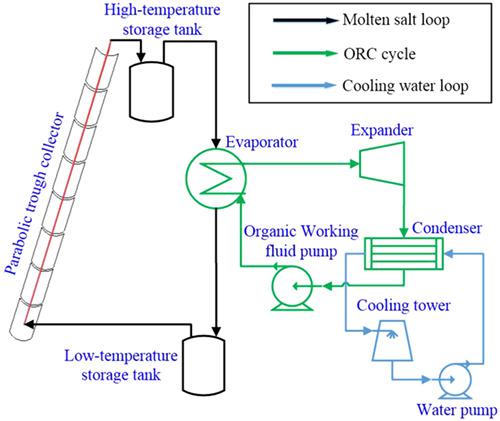当前位置:
X-MOL 学术
›
Int. J. Energy Res.
›
论文详情
Our official English website, www.x-mol.net, welcomes your
feedback! (Note: you will need to create a separate account there.)
Thermoeconomic analysis on a molten salt parabolic trough‐based concentrated solar organic Rankine cycle system
International Journal of Energy Research ( IF 4.3 ) Pub Date : 2020-01-23 , DOI: 10.1002/er.4894 Jun Fen Li 1 , Hang Guo 1 , Qing Peng Meng 1 , Yu Ting Wu 1 , Fang Ye 1 , Chong Fang Ma 1
International Journal of Energy Research ( IF 4.3 ) Pub Date : 2020-01-23 , DOI: 10.1002/er.4894 Jun Fen Li 1 , Hang Guo 1 , Qing Peng Meng 1 , Yu Ting Wu 1 , Fang Ye 1 , Chong Fang Ma 1
Affiliation

|
Solar thermal electricity generating technology is an alternative solution to energy crises and environmental problems, which has caused wide concern in recent decades. In this paper, a molten salt parabolic trough‐based concentrated organic Rankine cycle system is proposed and investigated. A quadribasic nitrate salt with low melting temperature is employed as a heat transfer and storage medium. A stable heat transfer and economic model is established with Matlab. The radial and axial temperature distributions in the collector tube are obtained, and the impact of condensation and evaporation temperatures on the heat transfer area is analyzed. Results show that the temperature along the axial direction linearly increases, and the temperature at the collector tube exit decreases with the increase of molten salt mass flow rate. The maximum temperature difference along the radial direction of the collector tube happens in the annular gap. Heat transfer and thermodymanic analysis indicates that condensation temperature has a more evident effect on heat transfer area than that of evaporation temperature. An increase in condensation temperature leads to a decrease in the evaporator area, the condenser area increases, and the total area decreases. Economic analysis indicates the collector cost plays a predominant role in total capital costs, and decreasing molten salt mass flow rate can considerably reduce collector cost. Levelized energy cost sensitivity analysis indicated that operation time per year has a more evident effect than that of the four factors. Heat transfer and economic analysis on the system helps in the selection of operation parameters.
中文翻译:

基于熔融盐抛物线槽的集中式太阳能有机朗肯循环系统的热经济学分析
太阳能热发电技术是能源危机和环境问题的替代解决方案,近几十年来引起了广泛关注。本文提出并研究了基于熔盐抛物线槽的浓缩有机朗肯循环系统。具有低熔融温度的四元硝酸盐用作传热和存储介质。用Matlab建立了稳定的传热和经济模型。获得了集热管中的径向和轴向温度分布,并分析了冷凝和蒸发温度对传热面积的影响。结果表明,随着熔盐质量流量的增加,轴向温度线性增加,集热管出口温度降低。沿集热管径向方向的最大温差出现在环形间隙中。传热和热力学分析表明,冷凝温度对传热面积的影响比蒸发温度更明显。冷凝温度的升高导致蒸发器面积的减少,冷凝器面积的增加,总面积的减小。经济分析表明,收集器成本在总资本成本中起着主要作用,降低熔盐质量流量可以大大降低收集器成本。分层的能源成本敏感性分析表明,每年的运行时间比这四个因素的影响更为明显。系统上的热传递和经济分析有助于选择运行参数。
更新日期:2020-01-23
中文翻译:

基于熔融盐抛物线槽的集中式太阳能有机朗肯循环系统的热经济学分析
太阳能热发电技术是能源危机和环境问题的替代解决方案,近几十年来引起了广泛关注。本文提出并研究了基于熔盐抛物线槽的浓缩有机朗肯循环系统。具有低熔融温度的四元硝酸盐用作传热和存储介质。用Matlab建立了稳定的传热和经济模型。获得了集热管中的径向和轴向温度分布,并分析了冷凝和蒸发温度对传热面积的影响。结果表明,随着熔盐质量流量的增加,轴向温度线性增加,集热管出口温度降低。沿集热管径向方向的最大温差出现在环形间隙中。传热和热力学分析表明,冷凝温度对传热面积的影响比蒸发温度更明显。冷凝温度的升高导致蒸发器面积的减少,冷凝器面积的增加,总面积的减小。经济分析表明,收集器成本在总资本成本中起着主要作用,降低熔盐质量流量可以大大降低收集器成本。分层的能源成本敏感性分析表明,每年的运行时间比这四个因素的影响更为明显。系统上的热传递和经济分析有助于选择运行参数。











































 京公网安备 11010802027423号
京公网安备 11010802027423号